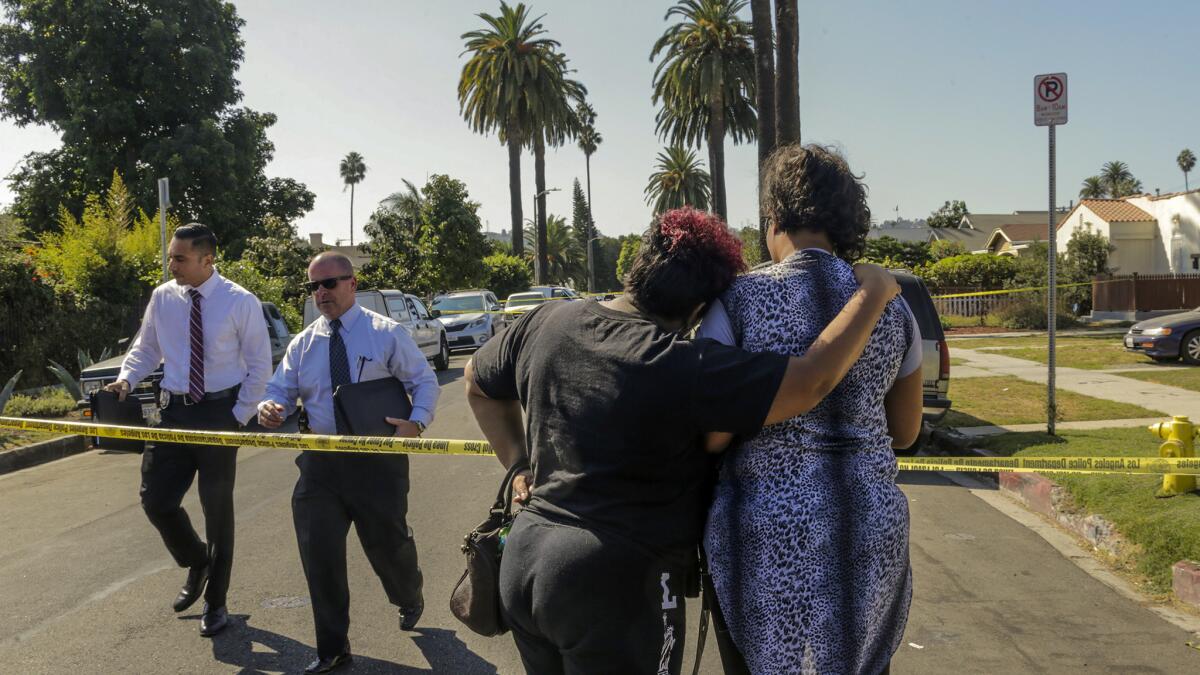Violent crime in L.A. jumps for third straight year as police deal with gang, homeless issues

- Share via
Violent crime increased in Los Angeles for the third straight year as police tried to stem a rash of homicides and gang-related shootings while dealing with a growing homeless population.
With more than 290 people killed in the city this year, homicides also rose for the third year in a row. Still, the city remains far safer than a decade ago, when 480 people were killed and there were 46% more robberies than this year.
For the record:
5:57 p.m. June 10, 2025An earlier version of this article incorrectly stated there were two homicides in Oakland in 2016 through Dec. 18, nine in 2015 and seven in 2014. There were 80 homicides in 2016 through Dec. 25, 83 in 2015 for the same time period and 78 in 2014.
According to statistics from the Los Angeles Police Department, robberies were up by 13%, aggravated assaults were up by 10% and rapes were down by 4% through Dec. 17, compared with the same period last year. Homicides were up by 5%.
Overall, violent crime was up by 10% over last year and 38% over two years ago.
Property crime also went up for the third consecutive year, with a 4% rise that was driven by double-digit increases in car-related thefts.
The upward trend of the last several years marks a reversal of a steady decline that began in the early 1990s, when crime was at all-time highs. In 1992, 1,094 people were killed in Los Angeles.
Similar trends were evident in the areas policed by the Los Angeles County Sheriff’s Department, where violent crime was up by 9% and property crime was up by 6% through Nov. 30 . It was the second year in a row that crime increased in sheriff’s department territory, which includes unincorporated parts of the county as well as cities such as Compton and Lancaster that contract for law enforcement services.
Elsewhere in the state, crime decreased in some Bay Area cities. San Francisco saw an increase in homicides and rapes, but robberies were down 13% and crime was down 10% overall through the end of November. Through Dec. 25, Oakland had 80 homicides, compared with 83 in 2015 for the same time period and 78 in 2014. Overall, crime in Oakland was down 6%.
Early this year, in response to a spike in homicides and shootings, the LAPD sent extra platoons of elite Metropolitan Division officers to South Los Angeles and intensified its use of daily crime statistics to identify problem spots.
By the time the emergency operation ended on Oct. 1, the rate of violent crime had stabilized in South L.A. But with resources concentrated there, some other parts of the city experienced upticks in crime.
Recently, the situation in South L.A. worsened — October was the worst month of the year for homicides — and the Metropolitan Division has increased its presence there again, said Asst. Chief Michel Moore, who oversees the LAPD’s patrol operations.
South Bureau, which includes much of South L.A. as well as the San Pedro area, finished the year with a 6% increase in homicides, 6% more rapes, 10% more robberies and 19% more aggravated assaults.
Overall, violent crime in South Bureau was up 15% over last year and 34% over two years ago.
The efforts of police officers on the streets have had an effect, but the root causes of crime – joblessness, homelessness, substance abuse – are deep and require the community’s help to solve, Moore said.
“It is like fighting fires – spot fires,” he said. “We have a finite number of resources, and at the end of the day, the LAPD isn’t going to fix this.”
The number of shooting victims in Los Angeles – 1,152 as of Dec. 17 -- was up 6% over last year and 23% over two years ago.
“Any one of those could have been a homicide by another inch or centimeter,” Moore said. “Our most pressing matter right now is shooting victims.”
Crime was up even in some parts of the city that are traditionally considered safe. In West Los Angeles, robberies were up by 16%, and motor vehicle theft was up by 31%. The LAPD’s Topanga Division saw a 41% increase in robberies and a 21% increase in motor vehicle theft.
Moore attributed the crime jump in Los Angeles to a combination of factors, including a resurgence in gang violence and the growth in homelessness. He also pointed to criminal justice reforms such as Proposition 47, which was approved by California voters in November 2014 and reduced some drug and property offenses from felonies to misdemeanors.
In Los Angeles County, the jail population has decreased, from 18,500 inmates just before Prop. 47 passed to about 16,500 inmates this November. Narcotics arrests have dropped, as busy police officers decide that the time needed to process a case is not worth it.
The result, some law enforcement officials say, is that more criminals are now on the streets instead of in jail and are not receiving the drug and mental health treatment the measure had promised. Without the threat of a felony prosecution, they say, defendants are less likely to choose treatment as an alternative to serving time.
“Unfortunately, we see that these programs are sold to the voters as having some positive impact, and so far in two years we haven’t seen that positive impact,” said Assistant Sheriff Jacques “Anthony” La Berge, who oversees patrol for the Sheriff’s Department.
But supporters of Prop. 47 dispute the theory that crime increases are connected to the measure. Misdemeanors can still result in sentences of up to a year in jail, and it is up to police officers and prosecutors to enforce those penalties, said Michael Romano, a lecturer at Stanford Law School.
“The idea that Prop. 47 has been responsible for an increase in crime in California over the past year or two is fake news, as far as I’m concerned,” he said. “There’s not one shred of evidence supporting the idea that Prop. 47 has had any impact on crime one way or another.”
The recent crime increases have also coincided with steep increases in homelessness. The latest homeless survey shows an 11% rise in the city of Los Angeles between January 2016 and the previous year, with a 5.7% jump countywide.
Homeless encampments can provide cover for chronic predators, and many homeless people are victims of crime, said Moore of the LAPD.
This year in Los Angeles, 13 homicide victims were homeless – up from six the previous year – and there was a 23% increase in aggravated assaults in which transients were the victims, Moore said.
The LAPD’s Central Division, which includes parts of downtown, skid row and Chinatown, saw a 59% increase in violent crime in 2015. This year, violent crime was down by 5% in Central, which Moore attributed to inroads made by police officers and social workers in homeless camps.
But crime statistics can sometimes obscure the realities of living in Los Angeles, where a single police station can serve dozens of square miles and hundreds of thousands of people.
Brent Page said his neighborhood of early 20th century Spanish and English Tudor cottages near the Inglewood border defies the image of South L.A. as a dangerous place.
At the neighborhood council meetings he leads, which are often attended by officers from the LAPD’s 77th Division, residents typically complain about minor issues such as street vending and illegally parked cars.
Page sees violent crime as largely confined to gang circles.
“A lot of people on these blocks know each other. They’re like family,” Page said of his neighborhood, Morningside Circle. “I know what the crime stats might say, what the perception might say, but it’s good to talk to people actually breathing and living in an area instead of going to the LAPD website and making generalizations.”
In Compton and nearby unincorporated areas, which are policed by the L.A. County Sheriff’s Department, homicides were up by 61%, with 37 through the end of November this year compared with 23 last year.
Most of the killings were gang-related, according to sheriff’s officials, including that of a 1-year-old girl in her crib who was hit by a bullet likely meant for her father.
The spike marks a return to the violence of years past: The Compton area had 32 homicides in 2014 and 40 homicides in 2013. Capt. Michael Thatcher, who runs the Compton Sheriff’s Station, said an increase in gang conflicts is a likely cause.
“I take it personally,” Thatcher said. “It’s our responsibility. Every deputy that works in that station understands that that’s something that’s very troubling for us.”
Times staff writer Richard Winton contributed to this report.
cindy.chang@latimes.com | Twitter: @cindychangLA
maya.lau@latimes.com | Twitter: @mayalau
ALSO
Authorities searching for L.A. couple who disappeared on trip to Big Sur
Southern California heads into wet weekend, with snow expected in the mountains
Man who lost gay pride nudity case against San Diego police dies of apparent suicide
More to Read
Sign up for Essential California
The most important California stories and recommendations in your inbox every morning.
You may occasionally receive promotional content from the Los Angeles Times.















